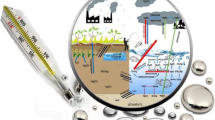Abstract
Arsenic, a carcinogenic trace element, threatens not only the health of millions of humans and other living organisms, but also global sustainability. We present here, for the first time, the global industrial-age cumulative anthropogenic arsenic production and its potential accumulation and risks in the environment. In 2000, the world cumulative industrial-age anthropogenic arsenic production was 4.53 million tonnes. The world-wide coal and petroleum industries accounted for 46% of global annual gross arsenic production, and their overall contribution to industrial-age gross arsenic production was 27% in 2000. Global industrial-age anthropogenic As sources (as As cumulative production) follow the order: As mining production >As generated from coal >As generated from petroleum. The potential industrial-age anthropogenic arsenic input in world arable surface in 2000 was 2.18 mg arsenic kg−1, which is 1.2 times that in the lithosphere. The development of substitute materials for arsenic applications in the agricultural and forestry industries and controls of arsenic emissions from the coal industry may be possible strategies to significantly decrease arsenic pollution sources and dissipation rates into the environment.




Similar content being viewed by others
References
Adriano DC (1986) Trace elements in the terrestrial environment. Springer, Berlin Heidelberg New York
Allard B (1995) Groundwater. In: Salbu B, Steinnes E (eds) Trace elements in natural waters. CRC, Boca Raton, Fla.
Banin A, Lawless JG, Whitten RC (1984) Global N2O cycles: terrestrial emissions, atmospheric accumulation and biospheric effects. Adv Space Res 4:207–216
Baur WH, Onishi H (1969) Arsenic. In: Wedepohl KH (ed) Handbook of geochemistry, vol 11-3. Springer, Berlin Heidelberg New York, p 33
Bockris JOM (1977) Environmental chemistry. Plenum, New York
Bowen HJM (1979) Environmental chemistry of the elements. Academic Press, New York
Chilvers DC, Peterson PJ (1987) Global cycling of arsenic. In: Hutchinson TC, Meema KM (eds) Lead, mercury, cadmium and arsenic in the environment. Wiley, New York, pp 279–301
Clarke LB, Sloss LL (1992) Trace Elements: emissions from coal combustion and gasification. IEA Coal Research, London
Edelstein D (1985) Arsenic. In: Mineral facts and problems, 1985 edn. Bureau of Mines Bulletin 675
Energy Information Administration (2001) International energy database. US Department of Energy: Washington, D.C.
Energy Information Administration (2002). International energy annual 2000. US Department of Energy, Washington, D.C.
Environment Canada (1993) Priority substances list assessment report: arsenic and its compounds. Environment Canada
Golding S (2001) Survey of typical soil arsenic concentrations in residential areas of the city of University Place. Washington State Department of Ecology, Olympia, Washington
Goyer RA, Klaassen CD, Waalkes MP (1995) Metal toxicology. Academic Press, San Diego, Calif.
Han FX, Su Y, Banin A, Monts DL, Plodinec MJ,Kingery WL, Triplett GE (2002) Industrial age anthropogenic inputs of heavy metals into the pedosphere. Naturwissenschaften 89:487–504
Hutchinson TC, Meema KM (1987) Lead, mercury, cadmium and arsenic in the environment. Wiley, New York
Kabata-Pendias A, Pendias H (1992) Trace elements in soils and plants. Lewis, Boca Raton, Fla.
Kelly T, Buckingham D, DiFrancesco C, Porter K, Goonan T, Sznopek J, Berry C, Cran M (2002) Historical statistics for mineral commodities in the United States. US Geological Survey
Koljonen T (1992) Geochemical atlas of Finland, part 2: geological survey of Finland
Lide DR (1996) CRC handbook of chemistry and physics, 77th edn. CRC, Boca Raton, Fla.
Loebenstein JR (1994) The materials flow of arsenic in the United States. US Bureau of Mines Information
Matschullat J (2000) Arsenic in the geosphere: a review. Sci Total Environ 249:297–312
Neff JM (1997) Ecotoxicology of arsenic in the marine environment. Environ Toxicol Chem 16:917–927
Nriagu JO (1979) Global inventory of natural and anthropogenic emissions of trace metals to the atmosphere. Nature 279:409–411
Nriagu JO, Pacyna JM (1988) Quantitative assessment of worldwide contamination of air, water and soils by trace metals. Nature 333:134–139
Pacyna JM (1987) Atmospheric emissions of arsenic, cadmium, lead and mercury from high temperature processes in power generation and industry. In: Hutchinson TC, Meema KM (eds) Lead, mercury, cadmium and arsenic in the environment. Wiley, New York, pp 69–87
Pettry DE, Switzer RE (2000) Arsenic concentrations in selected soils and parent materials in Mississippi. Mississippi State University, Miss., USA
Piver WT (1983) Mobilization of arsenic by natural and industrial processes. In: Fowler BA (ed) Biological and environmental efforts of arsenic. Elsevier, Amsterdam
Rice KC (1999) Trace element concentrations in streambed sediment across the continental United States. Environ Sci Technol 33:2499–2504
Schroeder D (1984) Soils-facts and concepts. International Potash Institute, Bern, Switzerland
Taylor SR, McLennan SM (1995) The geochemical evolution of continental crust. Rev Geophys 33:241–265
United Nations (1962) Demographic yearbook, 14th issue. United Nations, New York
United Nations (1976) World energy supplies 1950–1974. United Nations, New York
United Nations (1978) World energy supplies 1972–1976. United Nations, New York
US Bureau of the Census (1999) World population profile: 1999. US Government Printing Office, Washington, D.C.
US Environmental Protection Agency (USEPA) (2002a) Implementation guidance for the arsenic rule. US Environmental Protection Agency; US Government Printing Office, Washington, D.C.
US Environmental Protection Agency (USEPA) (2002b) Manufacturers to use new wood preservatives, replacing most residential uses of CCA, http://www.epa.gov/pesticides/factsheets/chemicals/cca_transition.htm (verified 7 May 2003)
Wedepohl KH (1995) The composition of the continental crust. Geochim Cosmochim Acta 59(7):1217–1232
Woytinsky WS, Woytinsky ES (1953) World population and production: trends and outlook. Lord Baltimore Press, Baltimore, Md.
Acknowledgements
This work was supported in part by funding from US Department of Energy's Office of Science and Technology through Cooperative Agreement DE-FC26-98FT-40395. We also thank three anonymous reviewers for their helpful comments and suggestions.
Author information
Authors and Affiliations
Corresponding author
Rights and permissions
About this article
Cite this article
Han, F.X., Su, Y., Monts, D.L. et al. Assessment of global industrial-age anthropogenic arsenic contamination. Naturwissenschaften 90, 395–401 (2003). https://doi.org/10.1007/s00114-003-0451-2
Published:
Issue Date:
DOI: https://doi.org/10.1007/s00114-003-0451-2




